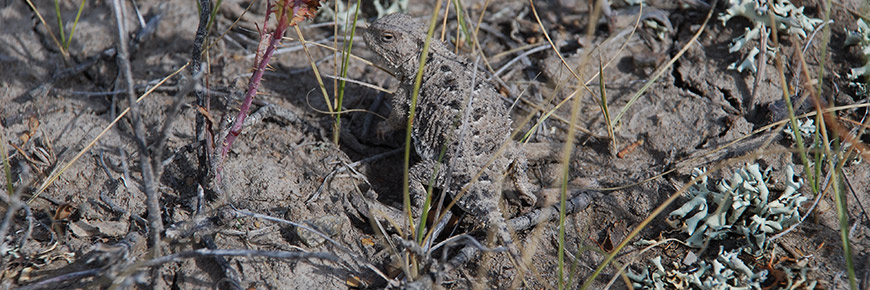
Greater Short-horned Lizard
Grasslands National Park
The Greater Short-horned Lizard is a small, cryptic, flat and wide bodied lizard, named after the many short horns on its head and body. It can be found in the rugged sloped areas between upland grassland and coulee bottoms throughout the Northern Great Plains as far south as central Mexico. In Canada, the species distribution is limited to four distinct areas in southeast Alberta and two small areas in southwest Saskatchewan, both located inside Grasslands National Park but isolated by distance.
The main threats to the Greater Short-horned Lizard include the conversion of native habitat to crop and forage production, high-intensity prolonged grazing, invasion and establishment of exotic plants and inclement or extreme weather conditions.
Protecting species
Parks Canada, working with partners, has been surveying areas of known and unknown occupancy to increase knowledge on species distribution in the park. Future plans include working with volunteers to survey population and monitor changes of the species abundance and distribution through time, as well as conducting invasive species management and removal to increase habitat quality in core areas.
How You Can Help
Volunteer events provide the opportunity to help Grasslands National Park monitor Greater Short-horned Lizard, while experiencing and learning about its biology and conservation needs.
Did you know? Short-horned Lizards are very difficult to see as they are very small and their camouflage is superior. Usually, you can only spot them if they move! In winter, the lizards will bury themselves under about 10 cm of loose soil on south facing slopes. How to identify: Short-horned Lizards do not resemble any other reptile or amphibian in the park. They look prehistoric, as they are a living remnant from the days of the dinosaurs! Where to view In Badland habitat. Bearpaw shale slopes in the Frenchman Valley and the lower reaches of Rock Creek. August is the best time to view them as the young of the year have been born, and they are temporarily more abundant.Connecting with nature
- Date modified :